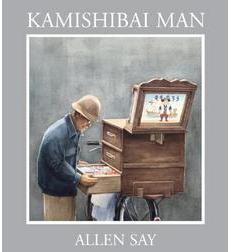Over the next several day, the students will learn about Kamishibai and listen to a story told with the traditional Kamishibai theater.
Most Kamishibai stories consist of 12 large (15” x 10.5″) illustrated cards that tell a story. On the back of each illustrated card is the text of the story.
Background of Kamishibai
In the Japanese language, Kamishibai ( kah-MEE-shee-bye) means “paper drama.” Kamishibai was popular for of street storytelling from the late 1920’s until the early 1950’s. A Kamishibai man was an itinerant storyteller who traveled from village to village by bicycle. His main occupation was selling candy. To entice the children to buy candy, he entertained them with stories.
To announce his arrival, he loudly clapped together two pieces of wood called hyoshigi (hee-yo-SHEE-gee). When the children heard the clapping, they came running, much as the children of today do when they hear the music of the ice cream truck. Children who purchased candy had the privilege of sitting in the front while others would be permitted to stay and listen to the stories, but would have to stand to the back of the crowd.
Below is a clip of a traditional Japanese storytelling; done with pictures that you slide in and out of a box. And of course, one great story teller.
 In order to get a better understanding of Kamishibai storytelling, students will read, Kamishibai Man by Alan Say
In order to get a better understanding of Kamishibai storytelling, students will read, Kamishibai Man by Alan Say
The Kamishibai man used to ride his bicycle into town where he would tell stories to the children and sell them candy, but gradually, fewer and fewer children came running at the sound of his clappers. They were all watching their new televisions instead. Finally, only one boy remained, and he had
no money for candy. Years later, the Kamishibai man and his wife made another batch of candy, and he pedaled into town to tell one more story–his own. When he comes out of the reverie of his memories, he looks around to see he is surrounded by familiar faces–the children he used to entertain have returned, all grown up and more eager than ever to listen to his delightful tales.
View the picture card story of the Momontaro Legend and/or watch and listen to the story told by a 6th grade student below.
Challenge:
Retell any story or create your own story using the traditional Kamishibai story-cards. If you would like blank story-cards, please ask Ms. Eyer. Listen to the story below that was written and told by Benji.

